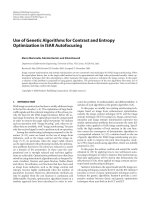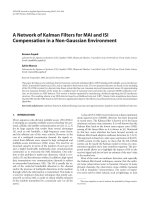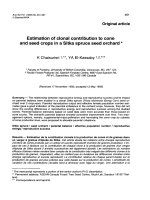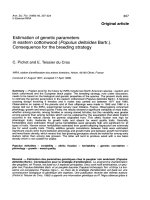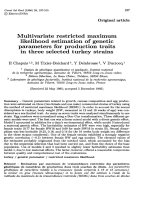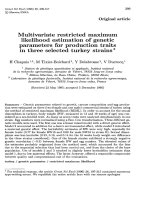Estimation of genetic parameters for production and reproduction traits in murrah buffaloes - Trường Đại học Công nghiệp Thực phẩm Tp. Hồ Chí Minh
Bạn đang xem bản rút gọn của tài liệu. Xem và tải ngay bản đầy đủ của tài liệu tại đây (191.26 KB, 7 trang )
<span class='text_page_counter'>(1)</span><div class='page_container' data-page=1>
<i><b>Int.J.Curr.Microbiol.App.Sci </b></i><b>(2017)</b><i><b> 6</b></i><b>(11): 4297-4303 </b>
4297
<b>Original Research Article </b>
<b>Estimation of Genetic Parameters for Production and </b>
<b>Reproduction Traits in Murrah Buffaloes </b>
<b>Vikram Jakhar*, A.S. Yadav and S.S. Dhaka </b>
Department of Animal Genetics & Breeding, Lala Lajpat Rai University of Veterinary and
Animal Sciences, Hisar, Haryana, India
<i>*Corresponding author </i>
<i><b> </b></i> <i><b> </b></i><b>A B S T R A C T </b>
<i><b> </b></i>
<b>Introduction </b>
India ranks first in total milk production in
world. Out of which almost half (55%) of
milk production in country is shared by
buffaloes. Murrah is one of the best milch
breed in India. Murrah breed of buffalo is
considered to be the best milk-cum-meat
breed. The home tract of breed is around the
Southern part of Haryana comprising the
districts of Rohtak, Jind, Hisar, Gurgaon and
Delhi. Home tract has relatively hot and dry
climate. Success of dairy industry depends on
the selection of high producing animals.
The data records of Murrah buffaloes from history cum pedigree sheets maintained over a
period of 24 years(1992-2015) at Buffalo research centre(BRC), LUVAS, Hisar and
Animal farm ICAR-CIRB, Hisar, were analysed to estimate heritability(h2), genetic and
phenotypic correlation among various production and reproduction traits. Production traits
whose genetic parameters analysed were Total lactation milk yield (TLMY), 305 days
milk yield (305MY), Peak yield (PY) and Lactation length (LL) whereas, reproduction
traits include Dry period (DP), Service period (SP) and Calving interval (CI). Data set
analysed includes records of 2959 buffaloes which were progeny of 219 sires. Based upon
analysis, higher heritability estimates for TLMY, 305MY, PY (h2=0.392±0.114,
0.348±0.118, 0.328±0.122 respectively) were recorded. Comparatively lower estimates of
heritability for LL, DP, SP, CI (h2= 0.090 ±0.08, 0.224 ±0.09, 0.211±0.0, 0.211±0.09
respectively) were recorded. High heritability estimate of production traits help to
conclude their significance in selection decision and it also indicate that production traits
will serve as a better tool for selective breeding, expected to lead to rapid aggregate
genetic gains in Murrah production. Further analysis on genetic correlation of production
traits we found higher values of genetic correlation as 0.998 ± 0.01(TLMY/ 305MY),
0.728 ± 0.09 (TLMY/PY) and 0.801 ± 0.06 (305MY/PY) whereas reproduction traits have
lower and negative genetic correlation. Low and negative genetic correlation of
reproduction traits indicate their little genetic role. Positive higher genetic correlations for
production traits indicated role of production traits in selection programmae. Further
critical analysis revealed that selection based on PY simultaneously will improve total
lactation milk yield and 305 days or less milk yield of Murrah buffaloes. Selection based
on peak yield also helpful for selection of buffalo at an early stage as compared to 305
days milk yield. It helps to conclude that peak yield may be the best trait to be taken in to
selection criteria in for improvement of milk production in Murrah buffaloes.
<b>K e y w o r d s </b>
Production traits,
Reproduction traits,
Murrah,
Heritability,
Genetic correlation,
Phenotypic
correlation.
<i><b>Accepted: </b></i>
30 October 2017
<i><b>Available Online:</b></i>
10 November 2017
<b>Article Info </b>
<i>International Journal of Current Microbiology and Applied Sciences </i>
<i><b>ISSN: 2319-7706</b></i><b> Volume 6 Number 11 (2017) pp. 4297-4303 </b>
</div>
<span class='text_page_counter'>(2)</span><div class='page_container' data-page=2>
<i><b>Int.J.Curr.Microbiol.App.Sci </b></i><b>(2017)</b><i><b> 6</b></i><b>(11): 4297-4303 </b>
4298
Therefore, in any breeding programmae it is
important to study the traits which have
importance in selection. Adequate knowledge
of genetic parameters namely heritability,
genetic and phenotypic correlations are
prerequisite for genetic improvement. The
estimates of heritability and genetic
correlations are important population
parameters required in planning of selection
experiments and various breeding strategies.
Therefore the present study was conducted to
investigate the genetic parameters for various
production and reproduction traits and also to
make a conclusive idea about the role of
different traits in selection programmae.
<b>Materials and Methods </b>
The data for present investigation was
collected from history cum pedigree sheets
maintained at Buffalo Research Centre
(BRC), Lala Lajpat Rai University of
Veterinary and Animal Sciences and Central
Institute for Research on Murrah Buffaloes
(CIRB) Hisar over a period of 24 years from
1992 to 2015. Production traits included in
the study were total lactation milk yield
(TLMY), 305 day milk yield (305MY) and
peak yield (PY). Whereas reproduction traits
were Lactation length (LL), Dry period (DP),
Service period (SP) and Calving interval (CI).
Buffaloes having lactation length of less than
100 days, having incomplete or incorrect
record were discarded. In general, group
feeding system followed except feeding of
pregnant animals and breeding bulls, which
were kept in individual pens. Ration fed to
lactating animals was computed on the basis
of milk production, live weight and stage of
pregnancy. The green fodder consisted of
maize and jowar during the months of June to
October and green berseem, mustard and oat
from November to March, whereas dry fodder
generally consisted of wheat bhosa. Also the
silage prepared from jowar and oat offered
during non-availability of green fodder in
May, June, October and November. Genetic
and phenotypic parameters were estimated by
paternal half sib correlation method using
mixed model analysis.
Genetic correlation: Genetic correlation
between two traits was obtained by dividing
the sire component of covariance between
two traits divided by the square root of the
product of sire component of variance for the
two traits. The standard error of genetic
correlation was estimated using formula given
by Robertson (1959).
Phenotypic correlation: Phenotypic
correlation between two traits was the sum of
sire and residual component of covariance
between two traits divided by the square root
of the product of the sire plus residual
component of variance for the two trait. The
standard error of phenotypic correlation was
computed by the formula given by Snedecor
and Cochran (1967).
<b>Results and Discussion </b>
The heritability estimates for TLMY was
0.392±0.114 (Table 1). Heritability values for
305MY, PY, LL, DP, SP and CI were
0.348±0.118, 0.328±0.122, 0.090 ±0.08,
0.224 ±0.09, 0.211±0.0 and 0.211±0.09
respectively. Moderate estimates for
heritability for TLMY was reported in present
study.
</div>
<span class='text_page_counter'>(3)</span><div class='page_container' data-page=3>
<i><b>Int.J.Curr.Microbiol.App.Sci </b></i><b>(2017)</b><i><b> 6</b></i><b>(11): 4297-4303 </b>
4299
Heritability for 305MY of value 0.348±0.118
was reported which was in accordance with
the findings of Chakraborty <i>et al.,</i> (2010),
Chaudhari, M. (2015) in Murrah buffaloes.
Higher values then the present reports was
given by Jakhar <i>et al.,</i> (2016) in Murrah
buffaloes. However, lower heritability
estimates were reported by Nath (1998) in
Murrah buffaloes.
Heritability estimates for PY was moderate in
Murrah. Similar estimates were also reported
by Kumar (2000), Dass and Sadana (2000),
Chaudhari, M. (2015) in Murrah buffaloes.
However, lower heritability estimates were
reported by Chakraborty <i>et al.,</i> (2010) in
Murrah buffaloes. Higher estimate for PY was
reported by Jakhar <i>et al.,</i> (2016) in Murrah
buffaloes. These moderate estimates of
heritability suggest that good possibility exists
for further improvement of these traits
through proper selection programme.
Selection using PY give rapid response to
direct selection as compared based on TLMY,
305MY as these traits takes long time to
measure. Optimal environment would
however, be a prerequisite for exploiting full
genetic potential of the animal. Also, the
moderate estimates in the present study
indicated that progeny testing along with
collateral relatives will help to make
improvement in these traits.
Low estimates of heritability for L was
supported by the findings of Nath (1998),
Kumar (2000) and Chaudhari (2015) in
Murrah buffaloes. However, higher
heritability estimates were reported by Singh
<i>et al.,</i> (2011) in Nili-Ravi buffaloes and
Jakhar<i> et al.,</i> (2016) in Murrah buffaloes.
<b>Table.1 </b>Estimates of heritability for different production and reproduction traits
<b>Sr no. </b> <b>Traits </b> <b>Heritability </b>
1. TLMY 0.392±0.114
2. 305MY 0.348±0.118
3. PY 0.328±0.122
4. LL 0.090±0.086
5. DP 0.224±0.096
6. SP 0.211±0.095
7. CI 0.211±0.095
<b>Table.2 </b>Genetic correlation between production and reproduction traits
<b>TLMY</b> <b>305MY</b> <b>PY</b> <b>LL</b> <b>DP</b> <b>SP</b> <b>CI</b>
<b>TLMY</b> 0.998±0.011 0.728±0.092 0.807±0.212 -0.224±0.230 0.175±0.229 0.172±0.201
<b>305MY</b> 0.801±0.068 0.783±0.292 -0.288±0.226 0.140±0.226 0.138±0.201
<b>PY</b> 0.148±0.323 -0.385±0.228 -0.098±0.223 -0.087±0.310
<b>LL</b> 0.582±0.441 0.793±0.305 0.645±0.145
<b>DP</b> 0.774±0.129 0.701±0.110
<b>SP</b> 0.210±0.110
<b>CI</b>
</div>
<span class='text_page_counter'>(4)</span><div class='page_container' data-page=4>
<i><b>Int.J.Curr.Microbiol.App.Sci </b></i><b>(2017)</b><i><b> 6</b></i><b>(11): 4297-4303 </b>
4300
<b>Table.3 </b>phenotypic correlation between different production and reproduction traits
<b>TLMY</b> <b>305MY</b> <b>PY</b> <b>LL</b> <b>DP</b> <b>SP</b> <b>CI</b>
<b>TLMY</b> 0.928±0.11** 0.554±0.092** 0.710±0.21** -0.067±0.230* -0.367±0.229* -0.347±0.189*
<b>305MY</b> 0.672±0.068** 0.473±0.292** -0.008±0.226* -0.229±0.226* -0.212±0.206*
<b>PY</b> 0.028±0.323* -0.091±0.228* -0.023±0.223* -0.019±0.203*
<b>LL</b> 0.190±0.441** 0.530±0.305* 0.513±0.285*
<b>DP</b> 0.765±0.129** 0.685±0.109**
<b>SP</b> 0.210±0.110**
<b>CI</b>
*p<0.05, **p<0.01.TLMY=Total lactation milk yield; 305DMY=305 Days milk yield; PY=Peak yield;
LL=Lactation length; DP=Dry period; SP=Service period; CI=Calving interval.
Furthermore, the estimates of heritability for
DP, SP and CI were low. Estimates of similar
magnitude were also reported by Kumar
(2000), Raheja <i>et al.,</i> (2000), Chander (2002),
Godara (2003), Chakraborty <i>et al.,</i> (2010),
Chaudhari, M. (2015) and Jakhar <i>et al.,</i>
(2016) in Murrah buffaloes. However, higher
heritability estimates were reported by Saha <i>et </i>
<i>al.,</i> (2000) in Murrah buffaloes. The lower
values of heritability estimates of various
reproduction traits in the present study
revealed that these traits were largely under
the influence of environmental effects.
Therefore improvement in the environmental
condition might help in more precise
estimation of these reproduction traits.
Genetic and phenotypic correlations along
with standard errors of various production and
reproduction traits were presented in Tables 2
and 3, respectively.
The TLMY had a high positive genetic
correlation with 305MY, PY and LL of the
order 0.998±0.011, 0.728±0.092 and
0.807±0.212 respectively and low and
negative genetic correlation with DP. The
phenotypic correlation of TLMY was found
to be positive and highly significant (p<0.01)
with 305 MY, PY and LL. whereas, negative
and significant with DP. Higher genetic
correlation among TLMY, 305MY and PY
revealed that selection can be done based on
any of the milk production trait. Selection for
</div>
<span class='text_page_counter'>(5)</span><div class='page_container' data-page=5>
<i><b>Int.J.Curr.Microbiol.App.Sci </b></i><b>(2017)</b><i><b> 6</b></i><b>(11): 4297-4303 </b>
4301
and phenotypic correlations between various
production traits. The PY had high significant
and positive genetic correlation with TLMY
(0.93±0.04) and 305 DMY (0.874±0.046) had
negative correlation with DP. These findings
indicated that PY was found as a good
indicator of productivity for improving
TLMY and SLMY. Similar association was
observed among LL and lactation milk yield.
The high positive genetic and phenotypic
correlations of PY and LL with TLMY and
305 DMY whereas, negative genetic and
phenotypic correlation with DP. These results
indicated the selection on the basis of PY and
LL will not only reduces the unproductive life
in the form of DP but also increases the
TLMY. Present study revealed that TLMY
had positive and significant phenotypic
correlation with LL and PY these results are
supported by the reports of Suresh <i>et al.,</i>
(2004).Lactation length (LL) had
non-significant positive genetic correlation with
DP of the order 0.582±0.441. The
corresponding phenotypic correlation was
positive with high standard error. Service
period (SP) had high and positive genetic
correlation with CI whereas; the
corresponding phenotypic correlation was
positive and significant. TLMY had low and
positive genetic correlation with SP and CI of
the order 0.175±0.229 and 0.172±0.201 and
negative and significant phenotypic
correlation with SP and CI. Similar higher
values of genetic and phenotypic correlation
of TLMY with LL and lower values for
TLMY with CI was reported by Malhado <i>et </i>
<i>al., </i>(2009), Suhail<i> et al.,</i> (2009), Seno <i>et al.,</i>
(2010) and El-bramony (2014). Higher
correlation of TLMY with the LL is expected
indicating higher milk yield leading to longer
lactation length. Similarly shorter CI is also
desirable. 305 Day milk yield had low and
positive genetic correlation with reproduction
traits (SP and CI). The corresponding
phenotypic correlations were negative and
significant. The genetic correlations of PY
were low and negative with SP and CI. The
phenotypic correlations were negative and
significant. Lower and negative genetic and
phenotypic correlation among production and
reproduction traits is favorable as selection
for high values of production traits will
reduce the unproductive life in the form of
DP, SP and CI. Lactation length (LL) had
high and positive genetic correlation with SP
and CI. The phenotypic correlation of LL was
positive and significant. These results are in
close agreement with the findings of Kumar <i>et </i>
<i>al.,</i> (2001) and Suresh <i>et al.,</i> (2004). Higher
and positive genetic correlation between LL
and CI was supported by the findings of
Barross<i> et al.,</i> (2016) indicating that increase
in LL will result in selection for longer CI.
Tonhati <i>et al.,</i> (2000b) and Aziz <i>et al.,</i> (2001)
found low genetic correlations between these
traits (-0.20 and 0.09, respectively). Dry
period was found to have high positive
genetic correlation with SP and CI. The
phenotypic correlation of DP with SP and CI
was positive and significant. These findings
were supported by the reports of Nath (1998),
Kumar (2000) and Kumar <i>et al., </i>(2001). The
high genetic and phenotypic correlation
between SP and CI was also reported by
Suresh <i>et al.,</i> (2004) and Singh and Barwal
(2012) in Murrah buffaloes. Low genetic and
phenotypic correlation values for different
reproductive traits were also reported by
Chaudhari (2015), Jakhar<i> et al.,</i> (2016) in
Murrah buffaloes.
</div>
<span class='text_page_counter'>(6)</span><div class='page_container' data-page=6>
<i><b>Int.J.Curr.Microbiol.App.Sci </b></i><b>(2017)</b><i><b> 6</b></i><b>(11): 4297-4303 </b>
4302
Analysis of genetic and phenotypic
correlation revealed that milk production
traits especially PY serve as a better criteria in
selection programmae for Murrah buffaloes.
<b>Acknowledgment </b>
We thank to department of animal genetics
and breeding, department of livestock
production and management and ICAR-CIRB
Hisar.
<b>References </b>
Aziz, M.A., Schoeman, S.J., Jordaan, G.F.,
Chafie, O.M. and Mahdy, A.T. (2001).
Geneticand phenotypic variation of
some reproductive traits in Egyptian
buffalo. <i>South African J. Anim. Sci. </i>
31(3).
Barross, C., Borquis, R., Fraga, A. and
Tonhati, H. (2016). Genetic parameter
estimates for production and
reproduction traits in dairy buffaloes.
<i>Rev. Caatinga, Mossoró, </i>29(216 – 221);
Jan. – Mar., 2016.
Chakraborty, D., Dhaka, S.S., Pander, B.L.,
Yadav, A.S. and Danpat (2010).
Genetic studies on 305 days and test
day milk yield records in Murrah
buffaloes.<i>Ind.J.Anim.Sci., </i> 80(8):
729-732.
Chander, R. (2002). Prediction of the
breeding value of sire’s for life time
performance traits in Murrah buffaloes.
Ph.D. Thesis, CCS Haryana
Agricultural University, Hisar.
Chaudhari, M. (2015). Genetic studies on
production, fertility and longevity traits
in Murrah and Niliravi buffaloes.
Dass, G. and Sadana, D.K. (2000). Factors
affecting some economic traits in
Murrah buffaloes. <i>Ind.J.Anim.Res</i>. 34:
43-45.
Dev, K., Dhaka, S.S., Yadav, A.S. and
Sangwan, S.K. (2015). Genetic
parameters of early performance traits
in Murrah buffaloes. <i>Haryana Vet. </i>
54(2): 144-146.
EI-Bramony, Manal, M. (2014). Esimation of
genetic and phenotypic parameter for
milkyield, lactation length, calving
interval and body weight in the first
lactation of Egyptian buffalo. <i>LifeSci.J. </i>
11(12): 1012-1019.
Galsar, N.S., Shah, R.S., Gupta, J.P., Pandey,
D.P., Prajapati, K.B. and Patel, J.B.
(2016). Genetic estimates of
reproduction and production traits in
Mehsana buffalo. <i>Indian J Dairy Sci</i>.
69(6).
Godara,A.(2003).Geneticstudiesonperformanc
etraitsindifferentlactationofMurrahbuffa
loes. M.Sc. Thesis, CCS Haryana
Agricultural University, Hisar, India.
Jakhar, V., Vinayak, A.K. and Singh, K.P.
(2016). Genetic evaluation of
performance attributes in Murrah
buffaloes.<i> Haryana veterinarian,</i> 55(1):
66-69.
Kumar, A. (2000). Genetic studies on first
lactation traits in Murrah buffaloes.
M.V.Sc. thesis, Haryana Agricultural
University, Hisar, India.
Kumar, A., Rana, Z.S., Dhaka, S.S., Dalal,
D.S., Singh, S. and Sethi, R.K. (2002).
Test day yield and lactation parameters
of Murrah buffaloes. In proceedings 7th
world congress on genetics applied to
livestock production. Aug. 19-23, 2002
Montpellier, France.
Kumar, A. and Tailor, S.P. (2010). Genetic
studies of production efficiency traits
and their uses in sire evaluation.
<i>Ind.J.Anim.Sci. </i>80(4): 989-992.
</div>
<span class='text_page_counter'>(7)</span><div class='page_container' data-page=7>
<i><b>Int.J.Curr.Microbiol.App.Sci </b></i><b>(2017)</b><i><b> 6</b></i><b>(11): 4297-4303 </b>
4303
Nath, M. (1998). Breeding value evaluation
for milk production in Murrah
buffaloes. M.Sc.Thesis, NDRI, Deemed
Univ. Karnal, India.
Raheja, K.L., Vinayak, A.K. and Kalra, S.
(2000). Genetic and phenotypic
parameters estimated from single and
multi-trait restricted maximum
likelihood procedure. <i>Ind.J.Anim.Sci., </i>
70(5): 497-500.
Robertson, A. (1959). The sampling variation
of genetic correlation coefficient.
<i>Biometrics</i>, 15: 469-485.
Saha, S. and Sadana, D.K. (2000). Effect of
genetic and non-genetic factors on
reproductive traits in Murrah buffaloes.
<i>Ind.J.Anim.Health., </i>39: 41-42.
Seno LO, Cardoso VL, Faro LEl, Sesana RC,
Aspilcueta-Borquis RR, Camargo CMF
de and Tonhati H (2010) Genetic
parameters for milk yield, age at first
calving and interval between first and
second calving in milk Murrah
buffaloes. Liv Res for Rural Dev 22(2):
1-8.
Singh, C.V. and Barwal, R.S. (2012).Use of
different animal models in prediction of
genetic parameters of first lactation and
herdlife traits of Murrah buffaloes. <i>Ind. </i>
<i>J.DairySci.</i>65 (5): 399-404.
Singh, T.P., Singh, R., Singh, G., Das, K.S.
and Deb, S.M. (2011). Performance of
production traits in Nili-Ravibuffaloes.
<i>Ind.J.Anim.Sci., </i>81(12): 1231-1238.
Snedecor, G.W. and Cochran, W.G. (1967).
<i>Statistical methods. </i> Oxford and IBH
Publ.Co., New Delhi, India.
Suhail, S.M., Qureshi, M.S., Khan, S.,
Ihsanullah and Durrani, F.R. (2009).
Inheritance of economic traits of dairy
buffaloes in Pakistan. <i>Sarhad J.Agric. </i>
25(1): 87-93.
Suresh, R., Bidarkar, D.K., Gupta, B.R. and
Sudhakar, K. (2004). Production and
reproduction performance of Murrah
buffaloes. <i>Ind.J.Anim.Sci., </i>74: 854-857.
Tailor, S.P. (1995). Genetic studies of first
lactation traits for prediction of lifetime
production and to develop suitable
selection criteria in urtibuffaloes. Ph.D.
thesis, Govind Vallabh Pant University
of Agriculture and Technology,
Pantnagar, UttarPradesh.
Tonhati, H., Vasconcellos, F. B.,
Albuquerque, l. G. (200B). Genetic
aspects of productive and reproductive
traits in a Murrah buffalo herd in São
Paulo. Brazil. Journal of Animal
Breeding and Genetics, Helsinque, v.
117, n. 5, p. 331-336.
<b>How to cite this article: </b>
</div>
<!--links-->
Báo cáo hóa học: " Research Article Joint Estimation of Mutual Coupling, Element Factor, and Phase Center in Antenna Arrays" pdf
- 9
- 293
- 0
